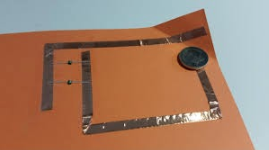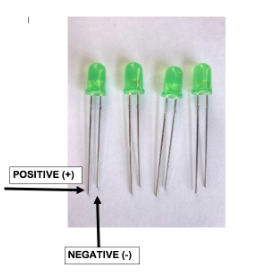
Paper Circuit Greeting Cards

Overview
Students will use knowledge of series circuits to create a closed circuit greeting card.
Learning Objectives
Students will:
- Understand circuits.
- Be able to use design thinking to create a circuit.
Vocabulary
Vocabulary Words:
-
Circuit: A circuit is a complete path around which electricity can flow. It must include a source of electricity, such as a battery.
-
Paper Circuit: A paper circuit is a low-voltage electronic circuit that is created on paper or cardboard using conductive copper tape, LEDs and a power source such as a coin-cell battery.
-
Closed Circuit: A Closed Circuit is a complete electrical circuit around which current flows or a signal circulates Similar Words: loop.
-
Series Circuit: A series circuit is a circuit in which resistors are arranged in a chain, so the current has only one path to take.
Pre-planning
To prepare for this lesson:
-
Your students will need some circuit background to complete this project.
-
To complete this project the students will need LED Lights, Batteries and Copper Tape. They can be be purchased on Amazon.
-
Here is a good video tutorial and step-by-step instructions by Chibitronics.
-
Below are ideas if this is your first time trying this with students:
-
Maker spaces paper circuits is a great resource with FREE Tutorial as well as free templates for cards.
-
-
Here is an advanced project on How to Make a Greeting Card.
-
Here is a possible design thinking template.
-
Watch the video on CIRCUITS or follow the tutorial:
-
Possible reflection questions.
Accommodations
See Accommodations Page and Charts on the 21things4students.net site in the Teacher Resources.
Steps
Directions for this activity:
-
The teacher will say to the students, "We have been talking about circuits in Science. Today you are gonna build a circuit greeting card."
-
Review circuits with students
-
Show the students an example of a sample card that you have created yourself or use one of the videos or tutorials from pre-planning.
-
Have the students decide who they are creating the card for and what they want the card to do.
-
Use Design thinking template if applicable
-
As students work, many will find that they can code multiple circuits, or if they create their own cards, they can create their own closed circuits.
-
Students will come into issues. It is important that STUDENTS solve the issue. Here are the most common issues:
-
DO NOT CUT THE COPPER TAPE - This could create a broken circuit. Show students how to fold accordingly around corners.
-
POSITION OF LED LIGHTS - Make sure your LED lights are correctly positioned for positive and negative.
-
POSITION OF BATTERY - Make sure your battery is positioned ON the copper tape. DO NOT TAPE THE BATTERY COMPLETELY. This will break your circuit.
-
WATCH YOUR TAPING - Less means more. Tape down enough to secure but be cautious of how much tape. You don’t want to tape down too much and break the circuit.
-

Assessment Options
Different options for assessing the students:
- Observations
- Check for understanding
- Students can reflect on the project using this Google Document.
- Students can also share out on SEESAW, Google Classroom, Flipgrid or Schoology.
- Design thinking template
MITECS COMPETENCIES & ISTE STANDARDS
MITECS: Michigan adopted the "ISTE Standards for Students" called MITECS (Michigan Integrated Technology Competencies for Students) in 2018.
Innovative Designer
4a. Students know and use a deliberate design process for generating ideas, testing theories, creating innovative artifacts or solving authentic problems.
4c. Students develop, test and refine prototypes as part of a cyclical design process.
4d. Students exhibit a tolerance for ambiguity, perseverance and the capacity to work with open-ended problems.
Computational Thinker
5a. Students formulate problem definitions suited for technology-assisted methods such as data analysis, abstract models and algorithmic thinking in exploring and finding solutions.
5d. Students understand how automation works and use algorithmic thinking to develop a sequence of steps to create and test automated solutions.
Devices and Resources
Device: PC, Chromebook, Mac, iPad
Browser: Chrome, Safari, Firefox, Edge, ALL
App, Extension, or Add-on:
Websites:
60 Seconds DIY Paper Circuit Tutorial
CONTENT AREA RESOURCES
ELA
Students could write a piece to go along with their card.
Integrated Arts
Create a design and create a paper circuit.
Science
Students learn about circuits and circuitry.
Credits
This task card was created by Courtney Conley, Utica Public Schools. January 2020.


